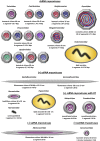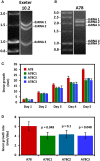Mycoviruses in Aspergilli: A Comprehensive Review
- PMID: 28932216
- PMCID: PMC5592211
- DOI: 10.3389/fmicb.2017.01699
Mycoviruses in Aspergilli: A Comprehensive Review
Abstract
Fungi, similar to all species, are susceptible to viral infection. Aspergillus is arguably the most well studied fungal genus because of its medical, ecological and economical significance. Mycoviruses were initially detected in Aspergillus species almost 50 years ago and the field continues to be active today with ground-breaking discoveries. The aim of the present review is to cover the scientific progress in all aspects of mycovirology as exemplified by Aspergillus-focused research. Initially an overview of the population studies illustrating the presence of mycoviruses in numerous important Aspergillus species, such as A. niger, A. flavus, and A. fumigatus with be presented. Moreover the intricacies of mycovirus transmission, both inter- and intra-species, will be discussed together with the methodologies used to investigate viral dispersion in a laboratory setting. Subsequently, the genomic features of all molecularly characterized mycoviruses to date will be analyzed in depth. These include members of established viral families, such as Partitiviridae, Chrysoviridae and Totiviridae, but also more recent, novel discoveries that led to the proposal of new viral families, such as Polymycoviridae, Alternaviridae and, in the context of the present review, Exartaviridae. Finally, the major issue of phenotypic effects of mycoviral infection on the host is addressed, including aflatoxin production in A. flavus, together with growth and virulence in A. fumigatus. Although the molecular mechanisms behind these phenomena are yet to be elucidated, recent studies suggest that by implication, RNA silencing may be involved.
Keywords: Aspergillus; hypervirulence; hypovirulence; mycovirus; mycovirus classification; mycovirus transmission; population study.
Figures




Similar articles
-
The Expanding Mycovirome of Aspergilli.J Fungi (Basel). 2024 Aug 17;10(8):585. doi: 10.3390/jof10080585. J Fungi (Basel). 2024. PMID: 39194910 Free PMC article. Review.
-
Efficient elimination of RNA mycoviruses in aspergillus species using RdRp-inhibitors ribavirin and 2'-C-methylribonucleoside derivatives.Front Microbiol. 2022 Oct 6;13:1024933. doi: 10.3389/fmicb.2022.1024933. eCollection 2022. Front Microbiol. 2022. PMID: 36274709 Free PMC article.
-
Identification of Diverse Mycoviruses through Metatranscriptomics Characterization of the Viromes of Five Major Fungal Plant Pathogens.J Virol. 2016 Jul 11;90(15):6846-6863. doi: 10.1128/JVI.00357-16. Print 2016 Aug 1. J Virol. 2016. PMID: 27194764 Free PMC article.
-
Analysis of an Intrinsic Mycovirus Associated With Reduced Virulence of the Human Pathogenic Fungus Aspergillus fumigatus.Front Microbiol. 2020 Jan 17;10:3045. doi: 10.3389/fmicb.2019.03045. eCollection 2019. Front Microbiol. 2020. PMID: 32010101 Free PMC article.
-
[Mycoviruses and importance in mycology].Mikrobiyol Bul. 2017 Oct;51(4):404-412. doi: 10.5578/mb.54128. Mikrobiyol Bul. 2017. PMID: 29153071 Review. Turkish.
Cited by
-
Completion of the sequence of the Aspergillus fumigatus partitivirus 1 genome.Arch Virol. 2020 Aug;165(8):1891-1894. doi: 10.1007/s00705-020-04660-0. Epub 2020 May 27. Arch Virol. 2020. PMID: 32458177 Free PMC article.
-
Fungal Viruses Unveiled: A Comprehensive Review of Mycoviruses.Viruses. 2023 May 19;15(5):1202. doi: 10.3390/v15051202. Viruses. 2023. PMID: 37243288 Free PMC article. Review.
-
An Overview of Mycoviral Curing Strategies Used in Evaluating Fungal Host Fitness.Mol Biotechnol. 2023 Oct;65(10):1547-1564. doi: 10.1007/s12033-023-00695-1. Epub 2023 Feb 25. Mol Biotechnol. 2023. PMID: 36841858 Free PMC article. Review.
-
Discovery and characterization of novel Aspergillus fumigatus mycoviruses.PLoS One. 2018 Jul 25;13(7):e0200511. doi: 10.1371/journal.pone.0200511. eCollection 2018. PLoS One. 2018. PMID: 30044844 Free PMC article.
-
Hypovirulence of Colletotrichum gloesporioides Associated with dsRNA Mycovirus Isolated from a Mango Orchard in Thailand.Viruses. 2022 Aug 30;14(9):1921. doi: 10.3390/v14091921. Viruses. 2022. PMID: 36146727 Free PMC article.
References
-
- Banks G. T., Buck K. W., Chain E. B., Darbyshire J. E., Himmelweit F., Ratti G., et al. . (1970). Antiviral activity of double stranded RNA from a virus isolated from Aspergillus foetidus. Nature 227, 505–507. - PubMed
Publication types
LinkOut - more resources
Full Text Sources
Other Literature Sources

